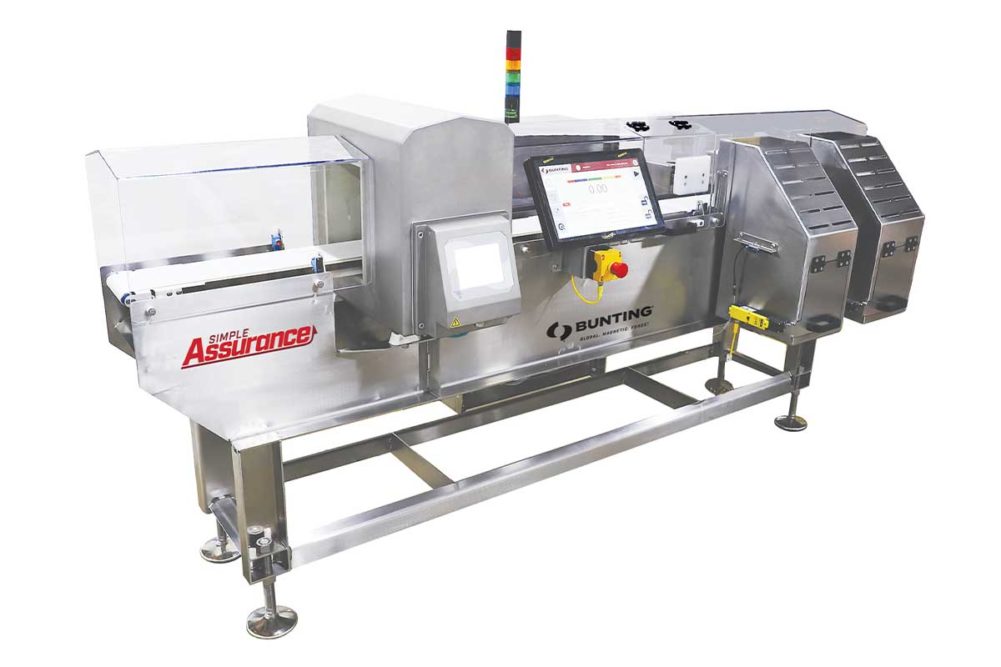Newer metal detection and X-ray technology now apply algorithms to enhance detection capability, reduce false rejects and improve efficiencies without turning down the sensitivities of the devices.
“With multi-simultaneous frequencies, we’re able to analyze these products with different lenses and apply what’s most appropriate for that particular product to get the best out of it without causing false rejects when these deviations occur,” said Rob Rogers, senior adviser for food safety and regulation, Mettler-Toledo
In addition to reducing waste and enhancing operating efficiencies, he pointed out these advancements in technology provide other benefits, such as more efficient detection of smaller contaminants.
Michael Wilks, global marketing director, Bunting Magnetics, suggested that merging technologies makes it easier to monitor results.
For instance, Bunting’s Simple Assurance unit, a new metal detector and checkweigher system, uses a combined software program to simplify final product inspection.
Recent developments in X-ray technology now allow bakeries to move the inspection point from individual packages to full case inspection with little or no reduction in detection capabilities, noted Ken Falk, regional sales representative, Eagle Product Inspection. The system also inspects different products on the same line, which saves equipment space and reduces overall investment.
Hyperspectral imaging, which has been around for a long time, has evolved as well.
“People now realize that they don’t need full hyperspectral imaging and highly complicated big computers to do it,” said Yuegang Zhao, chief commercial officer, KPM Analytics. “You can selectively pick a few wavelengths in the area where most common foreign materials are being found and use multispectral imaging.”
Such imaging can check for moisture or fat, and more easily identify a piece of white plastic sitting on mozzarella cheese of a pizza, for example. He suggested multiple systems provide complementary, and not necessarily redundant, inspection protection.
“Metal detectors can only detect metal, and X-rays can easily detect anything that’s heavier than water and have trouble detecting materials that are lighter than water. If you have issues with plastics or cardboard, X-rays are not as reliable, and then you might want to go with vision systems,” Mr. Zhao added. “But you only see what’s on the surface with vision systems, not what’s underneath, so you might want to consider X-rays or a metal detector as well to broaden the magnitude of the contaminants you can find.”
Several inspection equipment companies reported they are now employing new forms of artificial intelligence (AI) as well as existing data management systems to enhance inspection capabilities and efficiencies.
“Small and large bakeries are now looking into software solutions that can help them gather and manage various sources of data and use that information to monitor, report and follow up on audits, recalls and/or quality defects in production more efficiently than before,” said Bernardo Zermeño, customer development director, Rexfab. “Additionally, the pandemic has taught companies in all fields that a high level of automation can make the operations more robust toward unpredictable shocks, like a global pandemic.”
The company, for instance, offers Mekitec’s Data Manager software, which collects data from each X-ray system and enables quality assurance managers to verify the completion of required audit validation tests or monitor rejections at each X-ray system.
Mr. Zermeño said the use of data systems has increased since the pandemic when businesses became more familiar with using remote tools to identify areas for improvement with food safety and quality control equipment.
“Companies now understand that the biggest jumps in productivity and quality can be made with the right use of data,” he said.
Meanwhile, Eriez provides metal detectors with preset settings based on actual testing and application data provided by the bakery. In addition to automatic setup and product learning, the metal detectors offer one-touch log reporting and monitor rejects, faults, warnings, operator changes, product and setting changes and more. The company also provides a variety of automatic reject options.
This article is an excerpt from the September 2023 issue of Baking & Snack. To read the entire feature on Quality Assurance, click here.





